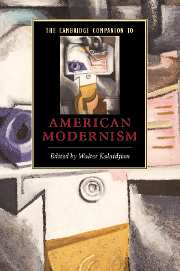5 - American modernism and the New Negro Renaissance
from Part II - Culture
Published online by Cambridge University Press: 28 May 2006
Summary
What it means to be a Negro in the modern world is a revelation much needed in poetry.
Sterling A. Brown, Negro Poetry and DramaRethinking American modernism
By the middle of the twentieth century, the New Critics had installed in the academy a brand of modernism that must have looked quite strange, even alien to the New Negro Renaissance artists of the teens, twenties, and thirties. It wasn't simply that the New Critics' version of modernism excluded New Negroes entirely, though this was certainly the case. More to the point, what would come to be known as “high modernism” robbed the era of the animating ideas and agendas that largely defined New Negro participation. The American modernism focused on Eliot, Pound, Frost, Stevens, Crane, and “lost generation” fiction (and perhaps a few “minor” figures, often women); or a modernism devoted to epistemological crisis, fragmentation, alienation, and cultural exhaustion was for New Negro artists (and, indeed, a much larger group of American writers) but one dimension of a vibrantly multifaceted, tumultuous, often contradictory cultural moment. Much more than the practice of elites, but rather a “full-fledged historical culture,” the modernism to which New Negroes contributed was a multivalent, often discursive era, capable of expressing unbridled optimism and chronic despair in the same breath. It was a moment that saw World War I and the collapse of the Ottoman Empire as both the end and the beginning of modern Western civilization, an era that celebrated democratic renewal, cultural plurality, and potential in mechanization, urbanization, and migration. And yet it was a moment that lamented the death of Christianity, the indeterminacy of language, and the demise of the cohesive self. Put more succinctly, a discussion of the New Negro Renaissance and its relation to American modernism begins not with our received New Critical sense of the era, but with a look at the constellation of ideas, movements, publishing venues, and artistic communities that comprised a heterodox modernism in which New Negroes participated fully.
- Type
- Chapter
- Information
- The Cambridge Companion to American Modernism , pp. 129 - 156Publisher: Cambridge University PressPrint publication year: 2005
- 6
- Cited by

